 |
 |
Our enthusiastic and extremely knowledgeable perennials team is here to answer your questions and help you choose the best perennials for your situation. There’s always something in bloom for sun, shade, butterflies, birds or deer resistance as well as a variety of bulbs for your space.
Stroll through our time-tested favorites and introduce yourself to the newest varieties. We garden with perennials too; we love them and it shows!
|
25 found, showing page 1 of 2
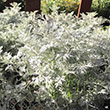
Outstanding silver-green, lacy leaves and stems. Excellent contrast plant in the sunny perennial garden. Drought tolerant. Deer resistant. USDA 6-9
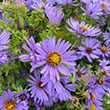
Height: 24 inches
Spread: 24 inches
Sunlight: full sun partial shade
Hardiness Zone: 4a
Other Names: Michaelmas Daisy
Description:
A mounded, bushy variety, perfect for adding color to fall gardens; beautiful sky blue daisy-like flowers with yellow centers are featured on green, fragrant foliage; easy to grow, requiring little to no maintenance; drought tolerant once established
Ornamental Features:
October Skies Aster has masses of beautiful sky blue daisy flowers with yellow eyes at the ends of the stems from early to late fall, which are most effective when planted in groupings. The flowers are excellent for cutting. Its narrow leaves remain dark green in color throughout the season.
Landscape Attributes:
October Skies Aster is a dense herbaceous perennial with a mounded form. Its relatively fine texture sets it apart from other garden plants with less refined foliage.
This is a relatively low maintenance plant, and is best cleaned up in early spring before it resumes active growth for the season. It is a good choice for attracting butterflies to your yard, but is not particularly attractive to deer who tend to leave it alone in favor of tastier treats. Gardeners should be aware of the following characteristic(s) that may warrant special consideration: Disease
October Skies Aster is recommended for the following landscape applications:
- Mass Planting
- General Garden Use
- Container Planting
Planting & Growing:
October Skies Aster will grow to be about 24 inches tall at maturity, with a spread of 24 inches. Its foliage tends to remain dense right to the ground, not requiring facer plants in front. It grows at a medium rate, and under ideal conditions can be expected to live for approximately 10 years. As an herbaceous perennial, this plant will usually die back to the crown each winter, and will regrow from the base each spring. Be careful not to disturb the crown in late winter when it may not be readily seen!
This plant does best in full sun to partial shade. It prefers to grow in average to moist conditions, and shouldn't be allowed to dry out. It is not particular as to soil type or pH. It is somewhat tolerant of urban pollution. This is a selection of a native North American species. It can be propagated by division; however, as a cultivated variety, be aware that it may be subject to certain restrictions or prohibitions on propagation.
October Skies Aster is a fine choice for the garden, but it is also a good selection for planting in outdoor pots and containers. It can be used either as 'filler' or as a 'thriller' in the 'spiller-thriller-filler' container combination, depending on the height and form of the other plants used in the container planting. It is even sizeable enough that it can be grown alone in a suitable container. Note that when growing plants in outdoor containers and baskets, they may require more frequent waterings than they would in the yard or garden.
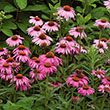
Fully double coral & raspberry blooms. Dark stems & foliage. USDA 4-9

Large, fragrant soft pink blooms. Compact habit. USDA 4-8

Height: 3 feet
Spacing: 30 inches
Sunlight: full sun
Hardiness Zone: 2a
Ornamental Features:
Shirley Temple Peony features bold lightly-scented white cup-shaped flowers with shell pink overtones and pink centers at the ends of the stems from late spring to early summer. The flowers are excellent for cutting. Its compound leaves remain green in color throughout the season.
Landscape Attributes:
Shirley Temple Peony is an herbaceous perennial with a more or less rounded form. Its medium texture blends into the garden, but can always be balanced by a couple of finer or coarser plants for an effective composition.
This is a relatively low maintenance plant, and should be cut back in late fall in preparation for winter. Deer don't particularly care for this plant and will usually leave it alone in favor of tastier treats. Gardeners should be aware of the following characteristic(s) that may warrant special consideration:
- Disease
Shirley Temple Peony is recommended for the following landscape applications:
- Mass Planting
- General Garden Use
Planting & Growing:
Shirley Temple Peony will grow to be about 30 inches tall at maturity, with a spread of 3 feet. When grown in masses or used as a bedding plant, individual plants should be spaced approximately 30 inches apart. The flower stalks can be weak and so it may require staking in exposed sites or excessively rich soils. It grows at a slow rate, and under ideal conditions can be expected to live for approximately 20 years. As an herbaceous perennial, this plant will usually die back to the crown each winter, and will regrow from the base each spring. Be careful not to disturb the crown in late winter when it may not be readily seen!
This plant should only be grown in full sunlight. It prefers to grow in average to moist conditions, and shouldn't be allowed to dry out. It is not particular as to soil pH, but grows best in rich soils. It is somewhat tolerant of urban pollution. This particular variety is an interspecific hybrid. It can be propagated by division; however, as a cultivated variety, be aware that it may be subject to certain restrictions or prohibitions on propagation.

Height: 3 feet
Spacing: 30 inches
Sunlight: full sun
Hardiness Zone: 2a
Ornamental Features:
Karl Rosenfeld Peony features bold lightly-scented fuchsia flowers with yellow anthers at the ends of the stems from late spring to early summer. The flowers are excellent for cutting. Its compound leaves remain green in color throughout the season.
Landscape Attributes:
Karl Rosenfeld Peony is an herbaceous perennial with a more or less rounded form. Its medium texture blends into the garden, but can always be balanced by a couple of finer or coarser plants for an effective composition.
This is a relatively low maintenance plant, and should be cut back in late fall in preparation for winter. Deer don't particularly care for this plant and will usually leave it alone in favor of tastier treats. Gardeners should be aware of the following characteristic(s) that may warrant special consideration:
- Disease
Karl Rosenfeld Peony is recommended for the following landscape applications:
- Mass Planting
- General Garden Use
Planting & Growing:
Karl Rosenfeld Peony will grow to be about 30 inches tall at maturity, with a spread of 3 feet. When grown in masses or used as a bedding plant, individual plants should be spaced approximately 30 inches apart. The flower stalks can be weak and so it may require staking in exposed sites or excessively rich soils. It grows at a slow rate, and under ideal conditions can be expected to live for approximately 20 years. As an herbaceous perennial, this plant will usually die back to the crown each winter, and will regrow from the base each spring. Be careful not to disturb the crown in late winter when it may not be readily seen!
This plant should only be grown in full sunlight. It prefers to grow in average to moist conditions, and shouldn't be allowed to dry out. It is not particular as to soil pH, but grows best in rich soils. It is somewhat tolerant of urban pollution. This particular variety is an interspecific hybrid. It can be propagated by division; however, as a cultivated variety, be aware that it may be subject to certain restrictions or prohibitions on propagation.
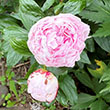
Height: 3 feet
Spacing: 30 inches
Sunlight: full sun
Hardiness Zone: 2a
Ornamental Features:
Sarah Bernhardt Peony features bold fragrant shell pink flowers at the ends of the stems from late spring to early summer. The flowers are excellent for cutting. Its compound leaves remain green in color throughout the season.
Landscape Attributes:
Sarah Bernhardt Peony is an herbaceous perennial with a more or less rounded form. Its medium texture blends into the garden, but can always be balanced by a couple of finer or coarser plants for an effective composition.
This is a relatively low maintenance plant, and should be cut back in late fall in preparation for winter. Deer don't particularly care for this plant and will usually leave it alone in favor of tastier treats. Gardeners should be aware of the following characteristic(s) that may warrant special consideration:
- Disease
Sarah Bernhardt Peony is recommended for the following landscape applications:
- Mass Planting
- General Garden Use
Planting & Growing:
Sarah Bernhardt Peony will grow to be about 30 inches tall at maturity, with a spread of 3 feet. When grown in masses or used as a bedding plant, individual plants should be spaced approximately 30 inches apart. The flower stalks can be weak and so it may require staking in exposed sites or excessively rich soils. It grows at a slow rate, and under ideal conditions can be expected to live for approximately 20 years. As an herbaceous perennial, this plant will usually die back to the crown each winter, and will regrow from the base each spring. Be careful not to disturb the crown in late winter when it may not be readily seen!
This plant should only be grown in full sunlight. It prefers to grow in average to moist conditions, and shouldn't be allowed to dry out. It is not particular as to soil pH, but grows best in rich soils. It is somewhat tolerant of urban pollution. This particular variety is an interspecific hybrid. It can be propagated by division; however, as a cultivated variety, be aware that it may be subject to certain restrictions or prohibitions on propagation.
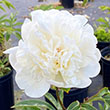
Plant Height: 24 inches
Flower Height: 3 feet
Spacing: 30 inches
Sunlight: full sun, partial shade
Hardiness Zone: 2a
Description:
An heirloom variety with large, globular double white blooms streaked with red at the center; a dependable, fragrant and vigorous plant; strong stems but staking required
Ornamental Features:
Festiva Maxima Peony features bold lightly-scented white flowers with crimson streaks at the ends of the stems from late spring to early summer. The flowers are excellent for cutting. Its compound leaves emerge burgundy in spring, turning green in color throughout the season.
Landscape Attributes:
Festiva Maxima Peony is an herbaceous perennial with a more or less rounded form. Its medium texture blends into the garden, but can always be balanced by a couple of finer or coarser plants for an effective composition.
This is a relatively low maintenance plant, and should be cut back in late fall in preparation for winter. It is a good choice for attracting bees and butterflies to your yard, but is not particularly attractive to deer who tend to leave it alone in favor of tastier treats. Gardeners should be aware of the following characteristic(s) that may warrant special consideration:
- Disease
Festiva Maxima Peony is recommended for the following landscape applications:
- Mass Planting
- General Garden Use
Planting & Growing:
Festiva Maxima Peony will grow to be about 24 inches tall at maturity extending to 3 feet tall with the flowers, with a spread of 3 feet. When grown in masses or used as a bedding plant, individual plants should be spaced approximately 30 inches apart. The flower stalks can be weak and so it may require staking in exposed sites or excessively rich soils. It grows at a slow rate, and under ideal conditions can be expected to live for approximately 20 years. As an herbaceous perennial, this plant will usually die back to the crown each winter, and will regrow from the base each spring. Be careful not to disturb the crown in late winter when it may not be readily seen!
This plant does best in full sun to partial shade. It does best in average to evenly moist conditions, but will not tolerate standing water. It is not particular as to soil pH, but grows best in rich soils. It is somewhat tolerant of urban pollution. This particular variety is an interspecific hybrid. It can be propagated by division; however, as a cultivated variety, be aware that it may be subject to certain restrictions or prohibitions on propagation.

Tall selection forms an upright mound of blue-green leaves. Tiny reddish-brown flower. Winter interest. USDA 4-9
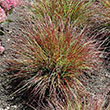
Bright red accent on blades. Compact. Tan seed heads. USDA 5-9
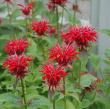
Height: 4 feet
Spacing: 30 inches
Sunlight: full sun partial shade
Hardiness Zone: 3a
Other Names: Bergamot, Oswego Tea
Ornamental Features:
Jacob Cline Beebalm has masses of beautiful clusters of fragrant red flowers at the ends of the stems from mid to late summer, which are most effective when planted in groupings. The flowers are excellent for cutting. Its fragrant pointy leaves remain forest green in color throughout the season.
Landscape Attributes:
Jacob Cline Beebalm is an herbaceous perennial with an upright spreading habit of growth. Its relatively coarse texture can be used to stand it apart from other garden plants with finer foliage.
This plant will require occasional maintenance and upkeep, and should be cut back in late fall in preparation for winter. It is a good choice for attracting bees, butterflies and hummingbirds to your yard, but is not particularly attractive to deer who tend to leave it alone in favor of tastier treats. Gardeners should be aware of the following characteristic(s) that may warrant special consideration: Spreading, Self-Seeding
Jacob Cline Beebalm is recommended for the following landscape applications:
- Mass Planting
- General Garden Use
- Naturalizing And Woodland Gardens
Planting & Growing:
Jacob Cline Beebalm will grow to be about 3 feet tall at maturity, with a spread of 3 feet. When grown in masses or used as a bedding plant, individual plants should be spaced approximately 30 inches apart. It grows at a fast rate, and under ideal conditions can be expected to live for approximately 5 years. As an herbaceous perennial, this plant will usually die back to the crown each winter, and will regrow from the base each spring. Be careful not to disturb the crown in late winter when it may not be readily seen!
This plant does best in full sun to partial shade. It is very adaptable to both dry and moist locations, and should do just fine under typical garden conditions. It is not particular as to soil type or pH. It is highly tolerant of urban pollution and will even thrive in inner city environments. This particular variety is an interspecific hybrid. It can be propagated by division; however, as a cultivated variety, be aware that it may be subject to certain restrictions or prohibitions on propagation.
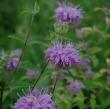
Showy clusters of lavender, pink or white pom pom flowers. Aromatic leaves. Native. Clay tolerant. USDA 3-9

Fragrant and drought-tolerant. Attracts hummingbirds & butterflies. Deer resistant. USDA 4-8
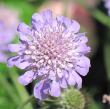
Lavender blooms. Long blooming. Compact. Clump-forming. USDA 5-9
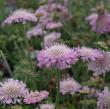
Pale-pink blooms. Long blooming. Compact. Clump-forming. USDA 5-9
25 found, showing page 1 of 2










